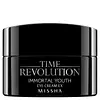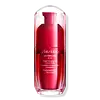What's inside
What's inside
 Key Ingredients
Key Ingredients

 Benefits
Benefits

 Concerns
Concerns

 Ingredients Side-by-side
Ingredients Side-by-side

Betula Alba Juice
AstringentCyclomethicone
EmollientDimethicone/Vinyl Dimethicone Crosspolymer
Skin ConditioningGlycerin
HumectantButylene Glycol
HumectantDipropylene Glycol
HumectantNiacinamide
SmoothingSilica
Abrasive1,2-Hexanediol
Skin ConditioningAcetyl Tetrapeptide-5
HumectantSh-Decapeptide-9
Skin ConditioningSodium Cocoyl Alaninate
Dimethicone
EmollientHydrogenated Lecithin
EmulsifyingCassia Alata Leaf Extract
AstringentAdenosine
Skin ConditioningHydrolyzed Myrtus Communis Leaf Extract
Skin ProtectingResveratrol
AntioxidantXanthophylls
Skin ConditioningAlgin
MaskingPolyglutamic Acid
Skin ConditioningTitanium Dioxide
Cosmetic ColorantPhenoxyethanol
PreservativeBetula Alba Juice, Cyclomethicone, Dimethicone/Vinyl Dimethicone Crosspolymer, Glycerin, Butylene Glycol, Dipropylene Glycol, Niacinamide, Silica, 1,2-Hexanediol, Acetyl Tetrapeptide-5, Sh-Decapeptide-9, Sodium Cocoyl Alaninate, Dimethicone, Hydrogenated Lecithin, Cassia Alata Leaf Extract, Adenosine, Hydrolyzed Myrtus Communis Leaf Extract, Resveratrol, Xanthophylls, Algin, Polyglutamic Acid, Titanium Dioxide, Phenoxyethanol
Water
Skin ConditioningDimethicone
EmollientGlycerin
HumectantDipropylene Glycol
HumectantSd Alcohol 40-B
AstringentSorbitol
HumectantPEG-10 Dimethicone
Skin ConditioningDimethicone/Vinyl Dimethicone Crosspolymer
Skin ConditioningCalcium Stearate
Cosmetic ColorantXylitol
HumectantMethyl Gluceth-10
EmulsifyingSodium Chloride
MaskingPEG/PPG-19/19 Dimethicone
EmulsifyingHydrogenated Polyisobutene
EmollientPhenoxyethanol
PreservativeCetyl Ethylhexanoate
EmollientErythritol
HumectantButylene Glycol
HumectantCellulose Gum
Emulsion StabilisingPEG/PPG-14/7 Dimethyl Ether
Skin ConditioningTocopheryl Acetate
AntioxidantRosa Damascena Flower Water
MaskingAlcohol
AntimicrobialParfum
MaskingTocopherol
AntioxidantDisodium EDTA
Ectoin
Skin ConditioningPhytosteryl/Octyldodecyl Lauroyl Glutamate
Skin ConditioningPPG-3 Dipivalate
Skin ConditioningLinalool
PerfumingSodium Metabisulfite
AntioxidantGeraniol
PerfumingSodium Carboxymethyl Beta-Glucan
CleansingGinkgo Biloba Leaf Extract
Skin ConditioningCitronellol
PerfumingZiziphus Jujuba Fruit Extract
Skin ConditioningOriganum Majorana Leaf Extract
AntiseborrhoeicNelumbo Nucifera Germ Extract
Skin ConditioningHydroxyproline
Skin ConditioningHouttuynia Cordata Extract
Skin ConditioningLactobacillus/Hibiscus Sabdariffa Flower Ferment Filtrate
Skin ConditioningSanguisorba Officinalis Root Extract
CleansingThymus Serpyllum Extract
Skin ConditioningPerilla Ocymoides Leaf Extract
TonicIris Florentina Root Extract
MaskingGanoderma Lucidum Stem Extract
Skin ConditioningWater, Dimethicone, Glycerin, Dipropylene Glycol, Sd Alcohol 40-B, Sorbitol, PEG-10 Dimethicone, Dimethicone/Vinyl Dimethicone Crosspolymer, Calcium Stearate, Xylitol, Methyl Gluceth-10, Sodium Chloride, PEG/PPG-19/19 Dimethicone, Hydrogenated Polyisobutene, Phenoxyethanol, Cetyl Ethylhexanoate, Erythritol, Butylene Glycol, Cellulose Gum, PEG/PPG-14/7 Dimethyl Ether, Tocopheryl Acetate, Rosa Damascena Flower Water, Alcohol, Parfum, Tocopherol, Disodium EDTA, Ectoin, Phytosteryl/Octyldodecyl Lauroyl Glutamate, PPG-3 Dipivalate, Linalool, Sodium Metabisulfite, Geraniol, Sodium Carboxymethyl Beta-Glucan, Ginkgo Biloba Leaf Extract, Citronellol, Ziziphus Jujuba Fruit Extract, Origanum Majorana Leaf Extract, Nelumbo Nucifera Germ Extract, Hydroxyproline, Houttuynia Cordata Extract, Lactobacillus/Hibiscus Sabdariffa Flower Ferment Filtrate, Sanguisorba Officinalis Root Extract, Thymus Serpyllum Extract, Perilla Ocymoides Leaf Extract, Iris Florentina Root Extract, Ganoderma Lucidum Stem Extract
Ingredients Explained
These ingredients are found in both products.
Ingredients higher up in an ingredient list are typically present in a larger amount.
Butylene Glycol (or BG) is used within cosmetic products for a few different reasons:
Overall, Butylene Glycol is a safe and well-rounded ingredient that works well with other ingredients.
Though this ingredient works well with most skin types, some people with sensitive skin may experience a reaction such as allergic rashes, closed comedones, or itchiness.
Learn more about Butylene GlycolDimethicone is a type of synthetic silicone created from natural materials such as quartz.
What it does:
Dimethicone comes in different viscosities:
Depending on the viscosity, dimethicone has different properties.
Ingredients lists don't always show which type is used, so we recommend reaching out to the brand if you have questions about the viscosity.
This ingredient is unlikely to cause irritation because it does not get absorbed into skin. However, people with silicone allergies should be careful about using this ingredient.
Note: Dimethicone may contribute to pilling. This is because it is not oil or water soluble, so pilling may occur when layered with products. When mixed with heavy oils in a formula, the outcome is also quite greasy.
Learn more about DimethiconeThis ingredient is a silicone used to improve the texture of products and absorb oil. It does not get absorbed into the skin.
Like other silicones, Dimethicone/Vinyl Dimethicone Crosspolymer helps condition the skin by creating a barrier. In this sense, it can act as an emollient and trap moisture in.
This ingredient is a type of elastomer.
Learn more about Dimethicone/Vinyl Dimethicone CrosspolymerDipropylene Glycol is a synthetically created humectant, stabilizer, and solvent.
This ingredient helps:
Dipropylene glycol is technically an alcohol, but it belongs to the glycol family (often considered part of the ‘good’ alcohols). This means it is hydrating and gentle on skin unlike drying solvent alcohols like denatured alcohol.
As a masking agent, Dipropylene Glycol can be used to cover the smell of other ingredients. However, it does not have a scent.
Studies show Dipropylene Glycol is considered safe to use in skincare.
Learn more about Dipropylene GlycolGlycerin is already naturally found in your skin. It helps moisturize and protect your skin.
A study from 2016 found glycerin to be more effective as a humectant than AHAs and hyaluronic acid.
As a humectant, it helps the skin stay hydrated by pulling moisture to your skin. The low molecular weight of glycerin allows it to pull moisture into the deeper layers of your skin.
Hydrated skin improves your skin barrier; Your skin barrier helps protect against irritants and bacteria.
Glycerin has also been found to have antimicrobial and antiviral properties. Due to these properties, glycerin is often used in wound and burn treatments.
In cosmetics, glycerin is usually derived from plants such as soybean or palm. However, it can also be sourced from animals, such as tallow or animal fat.
This ingredient is organic, colorless, odorless, and non-toxic.
Glycerin is the name for this ingredient in American English. British English uses Glycerol/Glycerine.
Learn more about GlycerinPhenoxyethanol is a preservative that has germicide, antimicrobial, and aromatic properties. Studies show that phenoxyethanol can prevent microbial growth. By itself, it has a scent that is similar to that of a rose.
It's often used in formulations along with Caprylyl Glycol to preserve the shelf life of products.